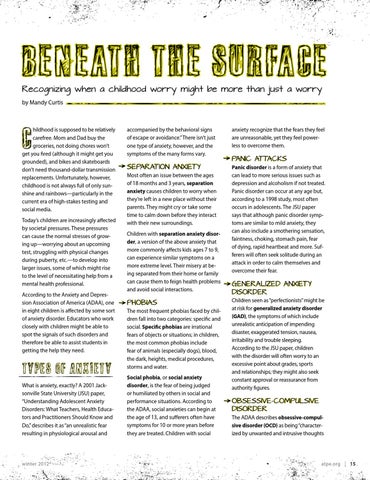Beneath the surface Recognizing when a childhood worry might be more than just a worry by Mandy Curtis
C
hildhood is supposed to be relatively carefree. Mom and Dad buy the groceries, not doing chores won’t get you fired (although it might get you grounded), and bikes and skateboards don’t need thousand-dollar transmission replacements. Unfortunately, however, childhood is not always full of only sunshine and rainbows—particularly in the current era of high-stakes testing and social media. Today’s children are increasingly affected by societal pressures. These pressures can cause the normal stresses of growing up—worrying about an upcoming test, struggling with physical changes during puberty, etc.—to develop into larger issues, some of which might rise to the level of necessitating help from a mental health professional. According to the Anxiety and Depression Association of America (ADAA), one in eight children is affected by some sort of anxiety disorder. Educators who work closely with children might be able to spot the signals of such disorders and therefore be able to assist students in getting the help they need.
Types of anxiety What is anxiety, exactly? A 2001 Jacksonville State University (JSU) paper, “Understanding Adolescent Anxiety Disorders: What Teachers, Health Educators and Practitioners Should Know and Do,” describes it as “an unrealistic fear resulting in physiological arousal and
winter 2012
accompanied by the behavioral signs of escape or avoidance.” There isn’t just one type of anxiety, however, and the symptoms of the many forms vary.
Separation anxiety
Most often an issue between the ages of 18 months and 3 years, separation anxiety causes children to worry when they’re left in a new place without their parents. They might cry or take some time to calm down before they interact with their new surroundings. Children with separation anxiety disorder, a version of the above anxiety that more commonly affects kids ages 7 to 9, can experience similar symptoms on a more extreme level. Their misery at being separated from their home or family can cause them to feign health problems and avoid social interactions.
Phobias PHOBIAS
The most frequent phobias faced by children fall into two categories: specific and social. Specific phobias are irrational fears of objects or situations; in children, the most common phobias include fear of animals (especially dogs), blood, the dark, heights, medical procedures, storms and water. Social phobia, or social anxiety disorder, is the fear of being judged or humiliated by others in social and performance situations. According to the ADAA, social anxieties can begin at the age of 13, and sufferers often have symptoms for 10 or more years before they are treated. Children with social
anxiety recognize that the fears they feel are unreasonable, yet they feel powerless to overcome them.
Panic ATTACKS attacks PANIC
Panic disorder is a form of anxiety that can lead to more serious issues such as depression and alcoholism if not treated. Panic disorder can occur at any age but, according to a 1998 study, most often occurs in adolescents. The JSU paper says that although panic disorder symptoms are similar to mild anxiety, they can also include a smothering sensation, faintness, choking, stomach pain, fear of dying, rapid heartbeat and more. Sufferers will often seek solitude during an attack in order to calm themselves and overcome their fear.
Generalized GENERALIZED anxiety ANXIETY disorder DISORDER
Children seen as “perfectionists” might be at risk for generalized anxiety disorder (GAD), the symptoms of which include unrealistic anticipation of impending disaster, exaggerated tension, nausea, irritability and trouble sleeping. According to the JSU paper, children with the disorder will often worry to an excessive point about grades, sports and relationships; they might also seek constant approval or reassurance from authority figures.
Obsessive-compulsive Obsessive-compulsive disorder disorder
The ADAA describes obsessive-compulsive disorder (OCD) as being “characterized by unwanted and intrusive thoughts
atpe.org | 15
